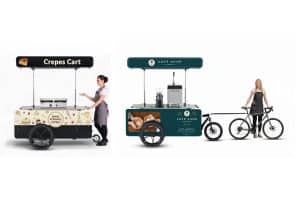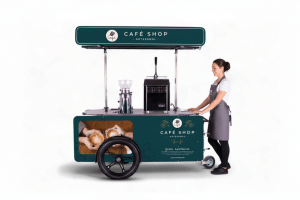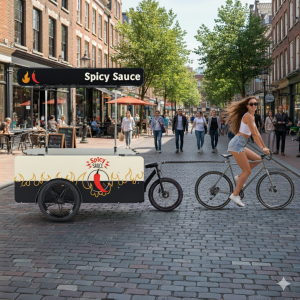Food Cart vs Food Bike: What To Use in Your Niche? (2025 Comparison)
The correct format can shave months off your path to profit. In 2025 the top two options for street food are Food Carts and Food Bikes—with carefully defined strengths and compromises. Below is a real-world, comparison based on costs, mobility, capacity, permitting, throughput (service speed), and profitability, with real-world examples. The examples reference BizzOnWheels equipment—M / L / XL carts and the ability to operate as push carts or bike-tow on our innovative drawbar and motorcycle wheel and hydraulic brake for stability and safe braking when in use.

1) Big picture: how to choose right the first time
Rule #1: Align the format with your niche and target locations.
Rule #2: Scale equipment to your workflow (target 60–90 seconds per order at busy times).
Rule #3: Optimize power, water, and storage before menu expansion.
Quick decision matrix
Food Cart
- Advantages: Space-efficient, versatile indoor/outdoor; elevators/doorways accommodated; rapid setup; easier HACCP compliance in small footprints; suitable for malls, markets, events.
- Disadvantages: Tied-up storage (especially M); complex menus may require prepping off-site.

Food Bike
- Pros: Excellent mobility in pedestrian zones; inexpensive operation; rolling billboard; ideal for campus activations, promenades, brand activations.
- Cons: Smaller capacity than Cart L/XL; refrigeration/power planning; weather exposure.

Bizz On Wheels note: All M / L / XL carts push cart or bike-towed capable. Our motorcycle wheel + hydraulic brakes provide stability and control on heavy loads (water, ice, frozen stock), so you can work weekdays indoors and weekends outdoors with the same unit.
2) What do you want to sell? (niche-to-format fit)
Coffee & Espresso
- Cart L / Bike: mobility + volume sweet spot. A Cart L with espresso machine, grinder, milk fridge, and hand-wash sink can deliver 60–120 beverages/hour at peak depending on menu and crew.
- Cart M / Bike: great for espresso tonics, cold brew, batch brew eventing.
Gelato / Ice Cream
Cart L/XL: ample area for display freezer/conservator, toppings, scoop washer, sink. Excellent in shopping malls and promenades.
Bike: ideal for cones/cups, promotions, and high traffic areas.
Fresh Juices & Lemonade
Bike / Cart M: speed + visual “theatre,” low expense; ideal for sporting events and parks.
Cart L: add display fridge, chiller, prep board to raise AOV.
Hot Street Food (plancha, grill, toasties)
Cart XL: flexible to plancha/contact grill + hot holding + sink; plan power/venting.
Trailer: standard for sophisticated hot menus (fryer, extraction, larger prep).
3) Operating costs, permits & complexity
Food Cart (M/L/XL)
-CapEx: medium (lower than trailer).
-OpEx: low/medium (depending on energy/location charges).
-Permits: generally simpler; ideally suited for indoor (malls) and outdoor.
-Complexity: low/medium; increases with size (M < L < XL).
Food Bike
-CapEx: low/medium (spec-dependent).
-OpEx: low (no petrol; little maintenance).
-Permits: simple mobile trading regulations; verify local pedestrian/cycling laws.
-Complexity: low; suited for MVP and brand activations.
4) Throughput, layout & power (what actually trims the queue)
Workflow/layout: 60–90 seconds per order in peak. Requirements:
-Clearly defined stations (order → prep → serve → pay).
-Smart reach zones (no unnecessary movements).
-Closely held mise en place (repeatability shift to shift).
Power & water:
-Coffee: espresso + grinder + milk chiller; mains or battery/inverter configurations.
-Cold: gelato storage/holding; ice for lemonades/smoothies.
-Hot: plancha/grill → more energy and ventilation (XL or trailer).
-Water: fresh/grey tanks + dedicated hand-wash basin (HACCP).
-Bike-tow information: map routes (gradients, curbs, paving). Hydraulic brakes + motorcycle wheel dampen vibrations and stabilize the unit with full fuel tanks.
5) More profitable? (orientation models)
Profitability is based on location, price, volume, and fixed costs (rent/fees, staff). Use these direction scenarios to compare:
Scenario A – Coffee in a mall (Cart L, push)
-4 peak hours × 80 drinks/hour = 320 drinks/day
-Avg ticket: €3 → €960/day gross
-COGS 28% → €269
-Mall fee + utilities: €120
-Labor (1.5 FTE/day): €200
-Other (maintenance, cups): €50
-Estimated net/day: ~€321
Scenario B – Lemonade & juices in a park (Bike-towed)
-3 peak hours × 60 drinks/hour = 180 drinks/day
-Avg ticket: €2.5 → €450/day gross
-COGS 32% → €144
-Public-space fees: €30
-Labor (1 FTE/day): €120
-Other: €30
-Estimated net/day: ~€126
Note: very low upfront cost—good for MVP or seasonal plays.
Scenario C – Hot snacks at a large festival (Trailer)
-6 peak hours × 120 portions/hour = 720 portions/day
-Avg ticket: €5 → €3,600/day gross
-COGS 35% → €1,260
-Event fees & logistics: €700
-Labor (3–4 FTE/day): €560
-Other (gas/oil/consumables): €180
-Estimated net/day: ~€900
Note: big upside with higher risk, higher investment, and seasonality.
Profit takeaways:
Bike & Cart M/L = low risk cash machines; ideal for validation, malls, campuses, promenades.
Cart XL = step-up for hot menus or higher event volume.
6) How to use M, L, or XL (within Food Carts)
– M – extremely small spaces, lean menus (espresso + 1–2 hero drinks, plain lemonade, low-rotation gelato).
– L – optimal balance: space for espresso + milk fridge + sink/toppings; most versatile for mall + outdoor.
– XL – two station menu (e.g., coffee + hot pastry / plancha) or high event level.
All three can be push or bike-towed; choose mode by calendar: indoor mid-week, outdoors events at weekends.
7) Permits & compliance (short, non-legal summary)
In any format:
- Register/notification of food business with your local competent authority.
- Implement HACCP-based practices (hazards, CCPs, temperature control, cleaning rosters, traceability, personal hygiene).
- Provide an exclusive hand-wash sink and food-grade cleanable surfaces.
- Pest-proofing, waste and potable/grey water management.
- Electrical/gas safety, fire safety kit; store LPG safely when in use.
- Public/private site and event organizer permissions.
Bizz On Wheels carts are constructed to integrate hand-wash modules, water management, refrigeration, and power sources—easy passing of inspections.
8) Roadmap: scaling without surprises
– Check with a Bike or Cart M/L in steady-traffic settings (mall/pedestrian zone).
– SOPs (order time, prep, cleaning, supplier cadence) require tightening.
– Upgrade to XL if you enter into hot food or encounter frequent lines.
– Insert units (multi-site) for ancillary days/hours (e.g., two units at two festivals on one weekend).
9) Quick suggestions by niche
– Coffee: Cart L (mall push, tow-bike outside). Upgrade to XL if lines persist for ergonomics + storage.
– Gelato: Cart L/XL to hold rigid display and toppings; Bike for tourist traffic/promenades.
– Lemonade & Juices: Bike or Cart M as a first option; L if you add cold snacks or want greater visual effect.
– Hot Snacks: XL if you want miniature hot functionality; Trailer for multi-size hot menus and volume.
10) FAQs
What if my budget is tight and I must test quick?
Start with a Food Bike or Cart M—excellent tickets, minimal cost, maximum mobility.
Can I use the same gear to operate in a mall and at festivals?
Yes. A Cart L or XL convertible from push to bike-towed (Bizz On Wheels’ motorcycle wheel + hydraulic brakes) does both.
What setup is “greener”?
Bike-towed operations significantly lower fuel usage and emissions—a huge marketing benefit in corporate presentations and tenders.
Conclusion
Desire instant affirmation, low risk, maximum autonomy? Go Food Bike or Cart M/L.
Must grow menu and volume but not too big? Cart XL is the middle ground.
Bizz On Wheels presents to you M / L / XL carts which function as bike-towed or push on the same platform—indoor-outdoor switching does not involve investing in an alternative fleet. Tell us your niche and target locations, and we’ll recommend the most suitable configuration (equipment, power, water, layout) and plan of action.
